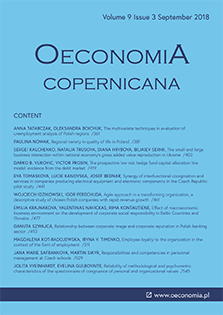Regional variety in quality of life in Poland
Regional variety in quality of life in Poland
Author(s): Paulina NowakSubject(s): Welfare systems, Methodology and research technology, Socio-Economic Research
Published by: Instytut Badań Gospodarczych
Keywords: quality of life; welfare measures; regional variety; Hellwig’s method; Ward’s method;
Summary/Abstract: Research background: Quality of life is viewed as the degree of people’s satisfaction of various needs, especially including material, spiritual, safety-related needs and life aspirations. The aspects taken into consideration are economic, spatial, environmental and cultural ones. Quality of life is therefore determined by various conditions in which a human lives and the source of which is the hierarchy of needs and a value system. At the same time, quality of life can be viewed in terms of collectivity (objective aspect) and an individual’s evaluation (subjective aspect). The former view shapes the existing living conditions and the latter results from the satisfaction from a specific person’s life, experiences and ambitions. The multidimensionality of the quality of life categories translates into difficulties in defining and measuring it, and constitutes an interesting research object. Purpose of the article: The purpose of the article is to diagnose and evaluate the variety of the quality of life in Polish voivodeships, in objective terms by building a synthetic measure allowing for estimating inequalities in the quality of life of regional communities. It was assumed that quality of life will be characterised by indicators grouped into the following areas: material living conditions, economic activity, health, education and living environment quality. Methods: The main method used for measuring quality of life is the linear ordering based on Z. Hellwig’s taxonomic measure which allows for organising voivodeships in terms of the quality of life of communities. Additionally, the cluster analysis (Ward’s agglomerative grouping method) was used, which allowed for distinguishing voivodeships similar in terms of the analysed phenomenon. Findings & Value added: During the realisation of the research goal, special attention was paid to the complexity of the quality of life issue and its measurement in terms of economy and rather important varieties in voivodeships were emphasized. The conducted analysis allowed for distinguishing groups of regions with the highest, high, low and the lowest quality of life.
Journal: Oeconomia Copernicana
- Issue Year: 9/2018
- Issue No: 3
- Page Range: 381-401
- Page Count: 21
- Language: English

